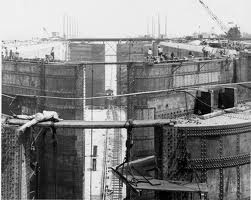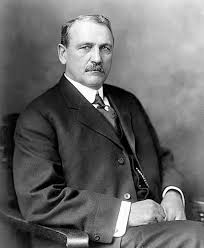The Panama Canal
John Frank Stevens, William C Gorgas and George Washington Goethals 1914 (opened)
The building of the 50-mile-long Panama Canal was a collosal project, joining together the Pacific and Atlantic oceans by digging away 240 million metric tons of earth through the Isthmus of Panama. Almost as big a project was sanitising the area around the canal, which was mosquito infested and home to serious diseases like Malaria and Yellow Fever.

Following several abortive attempts by other nations, including the French who had completed the Suez Canal in 1869, the construction of Panama Canal was eventually undertaken successfully by the USA. Unlike Suez, the Panama Canal did not follow a flat, level route through the desert, but rather one that passed through unpredictably variable and powerful rivers, a mountain range and thick jungle infested with poisonous snakes and mosquitos. Even with careful surveying and selection of route, elevation still varied by up to 312 feet along the proposed centre line.
President Theodore Roosevelt saw the canal both as an important path to economic prosperity, and as way to project US political power beyond the confines of North America for the first time by linking the two oceans and providing a conduit for American sea power and commerce. However, Panama was at that time a province of Colombia whose constitution forbade any release of sovereignty. Roosevelt then offered US protection to Panamanian groups who had been plotting independence, which was achieved in November 1903. Less than a year later, work on the canal began.
The project was initially put under the control of John Findley Wallace (1852-1921), a seasoned veteran of railroad construction, who was paid $25,000 a year, the second highest salary in the American government after the president. However, lured by a potential job offer he returned to the USA in 1906, when little progress had been made and the project had been struck by an outbreak of yellow fever. This angered, among others, Secretary of War William Taft, who demanded his resignation.

Wallace's replacement was John Frank Stevens, a former frontiersman and surveyor for the Great Northern Railroad. Stevens had already gained a reputation for effectiveness, and it was said that he had built more miles of railroad than any other man alive. Realising that the project's problems arose from political pressure to "make the dirt fly", he bravely took a radical change in direction and ordered the digging to stop. A focus on planning, infrastructure and logistics was then enforced. He improved and then leveraged railroad facilites to get the project moving again, introducing the use of swinging booms that could re-position railroad tracks without dismantling them. Special ploughs were also introduced that could empty whole train loads of earth in just a few minutes. Stevens organised digging to proceed from both ends of the canal inwards, each progressing towards the highest point. Thus, empty trains would always be proceeding up hill, while full trains would proceed down hill.
Equally important to the project was chief sanitary officer William Crawford Gorgas (1854-1920), who realised that the problems with disease stemmed ultimately from water in the form of ponds and swamps, as well as the public water systems. He implemented an extensive drainage and sanitation programme which successfully brought the dangerous diseases that were incapacitating the workforce under control.
In 1907 President Roosevelt appointed George Washington Goethals, a military engineer, as head of the project, and under his leadership the canal was finally completed in 1914, two years ahead of the 1916 target. Of benefit to the whole world, the achievement of the Panama Canal signalled American dominance in project management and engineering like no other project of the day.
